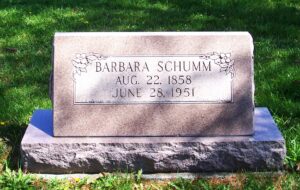
Barbara Schumm, Zion Lutheran Cemetery, Van Wert County, Ohio. (2012 photo by Karen)
This is the tombstone of Barbara Schumm, located in row 4 of Zion Lutheran Cemetery, Schumm, Van Wert County, Ohio. The marker is inscribed:
Barbara Schumm
Aug. 22, 1858
June 28, 1951
Maria “Barbara” Margaretha Schumm was born 22 August 1858, the tenth child born to Friedrich and Magdalena (Meyer) Schumm. Barbara was baptized at home on 26 August 1858 with Mrs. Barbara Schumm, Mrs. Buchner, and Mrs. Schinnerer as her sponsors. Both of her parents were German immigrants.
The Friedrich Schumm family in 1860, when Barbara was 2 years old: Friedrich Schumm, 46; Magdalena, 41; Catherine, 14; William, 20; John, 18; Friedrich, 16; Jacob, 13; Hannah, 11; Mary, 9; Lewis, 7; George, 4; and Barbara, 2. The father Friedrich was a farmer and all the children were born in Ohio. [1]
The Friedrich Schumm family in 1870: Friedrich, 56; Magdalena, 50; William, 30; Friedrich, 25; Mary, 19; Lewis, 16; George, 14; Barbara, 12; Henry, 9; and Ferdinand, 6. [2]
The Friedrich Schumm family in 1880: Friedrich, 66; Magdalena, 59; Barbara, 21; Henry, 18; and Ferdinand, 16. [3]
Barbara Schumm’s mother Magdalena died in 1897 and Barbara lived with her widowed father in 1900: Friedrich, 86; Barbara, 41; and Mary, 19, granddaughter. No occupation is given for Barbara or Mary and her father Friedrich is shown as landlord. [4] I am not sure who Mary was.
Barbara’s father Friedrich died in 1902 and by 1910 Barbara had moved to Fort Wayne, Indiana.
In 1910 Barbara lived in her own home at 1326 Wall Street in Fort Wayne. She was single and worked as a dressmaker. [5]
In 1920 Barbara lived in a home she owned on Sweeney Avenue in Fort Wayne: Barbara, 61; and Paula Koch, niece, 19, single. Paula was actually Barbara’s grand-niece, the daughter of William and Emelia (Schumm) Koch. Barbara worked as a seamstress and Paula worked for an electric manufacturing factory. Barbara rented a room to a married couple, Carl Seemeyer, 39, Ohio, and Flora Seemeyer, 33, Indiana. Carl was a commercial traveler and worked for a biscuit company. [6]
Ten years later, in 1930, Barbara, age 72 resided at the same address on Sweeney Avenue. She rented rooms to Edwin H Hasek, 27, Michigan; and Denver C Clark, 20, Indiana, both bookkeepers at a bank. Barbara was not employed and was likely retired by this time. [7]
In 1940 Barbara, 81, remained in her home at 1328 Sweeney. Living with her was her niece Anna Roehm, 33, single, born in Ohio. Anna was a footer in a hosiery factory and Barbara was not employed. [8] Anna was actually Barbara’s grand-niece and first cousin twice removed, the daughter of Friedrich & Henrietta Amalia Schumm.
Sometime within the next eleven years Barbara Schumm moved back to Schumm, where she died of pneumonia and old age on 28 June 1951. She was 92 years, 10 months, and 6 days old and was buried on 2 July. Her death certificate indicates that she was retired and that she never married.
[1] 1860 U.S. Census, Willshire, Van Wert, Ohio, p.425, dwelling 1065, family 1059, Frederic Schanen; digital image by subscription, Ancestry.com (https://www.ancestry.com/search/collections/7667/ : viewed 13 Dec 2020).
[2] 1870 U.S. Census, Willshire, Van Wert, Ohio, p.438B, dwelling 130, family 131, Fred Schumm; digital image by subscription, Ancestry.com (https://www.ancestry.com/search/collections/7163/ : viewed 13 Dec 2020).
[3] 1880 U.S. Census, Willshire, Van Wert, Ohio, ED 154, p. 450C, family 129, Frede Schumm; digital image by subscription, Ancestry.com (https://www.ancestry.com/search/collections/6742/ : viewed 13 Dec 2020).
[4] 1900 U.S. Census, Willshire, Van Wert, Ohio, ED 97, p.9, dwelling 181, family 195, Frederick Schumm; digital image by subscription, Ancestry.com (https://www.ancestry.com/search/collections/7602/ : viewed 13 Dec 2020).
[5] 1910 U.S. Census, Fort Wayne Ward 6, Allen, Indiana, ED 47, p.21A, dwelling 452, family 467, Barbara Schuma; digital image by subscription, Ancestry.com (https://www.ancestry.com/search/collections/7884/ : viewed 13 Dec 2020).
[6] 1920 U.S. Census, Fort Wayne Ward 6, Allen, Indiana, ED 56, p.3B, dwelling 67, family 70, Barbara Schumm; digital image by subscription, Ancestry.com (https://www.ancestry.com/search/collections/6061/ : viewed 13 Dec 2020).
[7] 1930 U.W. Census, Fort Wayne, Allen, Indiana, ED 24, p.22A, dwelling 472, family 485, Barbara M Schumm; digital image by subscription, Ancestry.com (https://www.ancestry.com/search/collections/6224/ : viewed 13 Dec 2020).
[8] 1940 U.S. Census, Fort Wayne, Allen, Indiana, ED 94-37, p.12B, house visited 278, Barbara Schumm; digital image by subscription, Ancestry.com (https://www.ancestry.com/search/collections/2442/ : viewed 13 Dec 2020).
[9] “Ohio, County Death Records, 1840-2001,” Van Wert, Ohio, Barbara Margareta Schumm, 28 Jun 1951; database with images, FamilySearch.org (https://www.familysearch.org/ark:/61903/3:1:3QS7-99ZY-YCWB?i=1157&cc=2128172&personaUrl=%2Fark%3A%2F61903%2F1%3A1%3AF6CT-YV8 : viewed 13 Dec 2020).

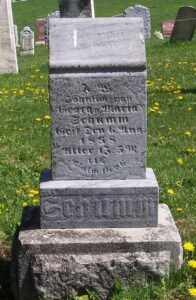
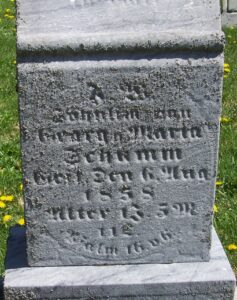
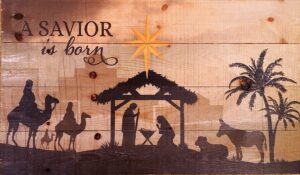
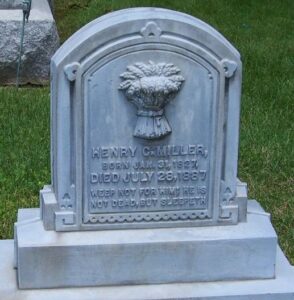

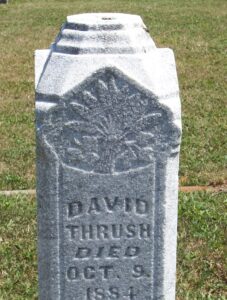

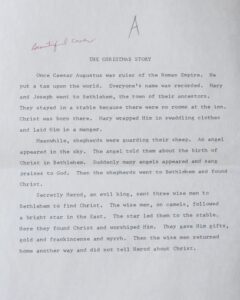
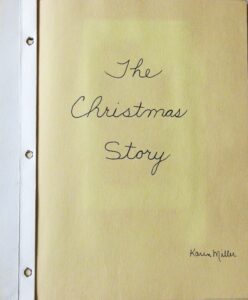

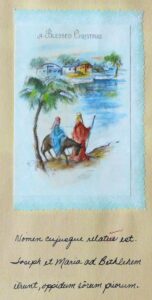

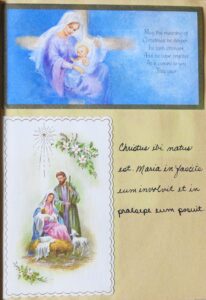
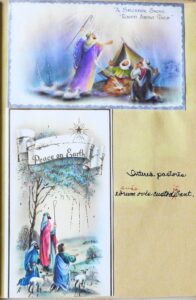

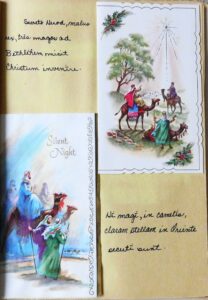
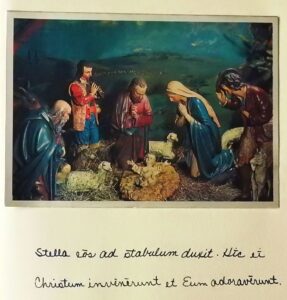
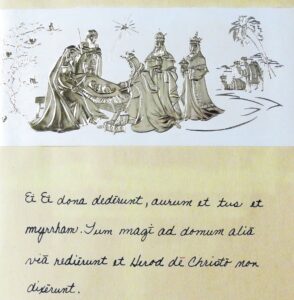




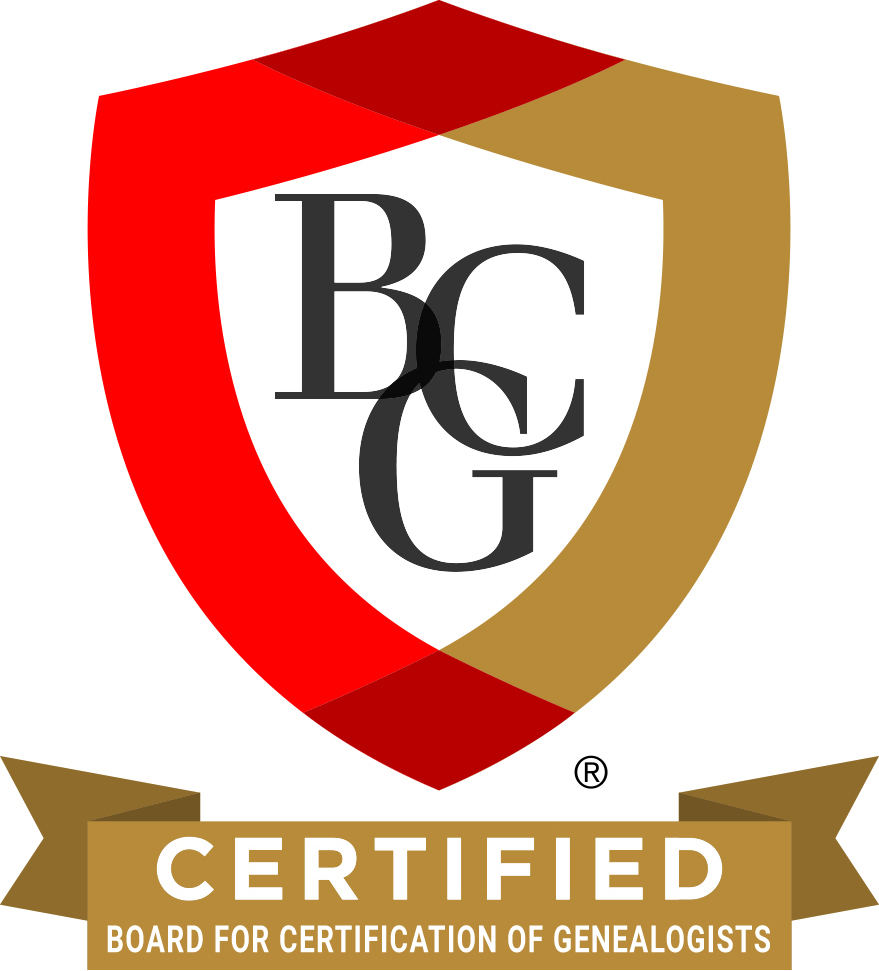


You are welcome!
You're welcome, Karen. I'm still working on this also. Thank you so much for all of your wonderful Mercer County…
Very interesting and great picture (I had neersee before) of the church! Thanks for sharing this, Karen.
Ha! I see why you say that. Your original surname was probably something similar to Schmitt.
Thank you for letting me know.